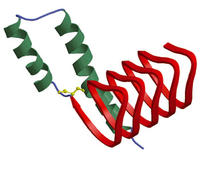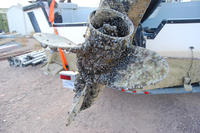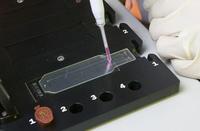-
Using ozone to kill prions dead

Prions are among the worst infectious-disease agents; these proteins are resistant to a wide variety of extreme disinfectant procedures; they have been identified as the culprits behind mad cow disease and chronic wasting disease in animals and humans, and are also implicated in Creutzfeldt-Jakob disease and other prion-related disorders
-
-
Food safety business plan competition
Two Michigan-based organizations announce a business plan competition for ventures in the food safety area; entrepreneurs with new food safety business concepts will compete for $10,000 prize
-
-
Kansas biolab project on life support

In 2008, DHS chose Manhattan, Kansas, as the location for a new, $650 million BioLab Level 4; the new lab was planned as a replacement for the aging Plum Island facility; critics argued that the lab’s location — in the middle of Tornado Alley and at the center a region which is home to a large portion of the U.S. beef industry – was not ideal for a facility doing research on deadly animal and human pathogens; it now appears that budgetary considerations have doomed to project
-
-
Discovery paves way for salmonella vaccine
More than 1.4 million cases of salmonella occur annually in the United States, at an estimated cost of $3 billion and the loss of 580 lives; around the world, this increasingly antibiotic-resistant food-borne bacteria that kills hundreds of thousands of people worldwide each year; , immunologists have taken an important step toward an effective vaccine against salmonella
-
-
Georgia Tech’s software for rapid analysis of food-borne pathogens
A team of Goergia Tech bioinformatics graduate students, led by a biology professor, worked in close collaboration with the Centers for Disease Control and Prevention (CDC) to create an integrated suite of computational tools for the analysis of microbial genome sequences
-
-
A bioterrorism threat for the birds?

In his first guest column, Leonard A. Cole, an expert on bioterrorism and on terror medicine who teaches at Rutgers University, explores the recent controversy over bird flu research, its implications on national security, and why efforts to curb information regarding the research will likely have limited success
-
-
Compound to help combat antibiotic-resistant superbugs
Chemists have created a compound that makes existing antibiotics sixteen times more effective against recently discovered antibiotic-resistant “superbugs”
-
-
Lack of use leads federal counterterror labs to find work elsewhere
Counterterrorism laboratories originally set up to test for dangerous biological or chemical substances have increasingly been used to assist in non-conventional tasks like testing oysters for shellfish contamination or identifying synthetic marijuana
-
-
Electron beam reduces virus-related health risk in lettuce, spinach
Current health-care costs in the United States associated with foodborne viruses are estimated at about $6 billion; scientists show that electron-beam irradiation can reduce the health risks in iceberg lettuce and spinach, but note that electron-beams are not meant to be used as a “stand-alone” or “clean-up” technology
-
-
Cold plasma reduces harmful bacteria on raw chicken
Recent high-profile outbreaks of foodborne illness have involved contaminated fresh produce, but the most common source of harmful bacteria in food is uncooked poultry and other meat products; studies have shown that plasma could successfully reduce pathogens on the surface of fruits and vegetables without cooking them, and scientists demonstrates that plasma can be an effective method for killing pathogens on uncooked poultry
-
-
Understanding – and averting -- drug resistance in bacteria
Bacterial resistance to antibiotics is growing exponentially, contributing to an estimated 99,000 deaths from hospital-associated infections in the U.S. annually; one reason that this is happening is that drug resistant proteins are transporting “good” antibiotics, or inhibitors, out of the cells, leaving them to mutate
-
-
Research collaboration to fight Campylobacter jejuni
Campylobacter, primarily C. jejuni, is the third leading cause of death from foodborne infections in the world; in the United States alone, it affects nearly 2.4 million people, causes an estimated 58,000 illnesses and 200 deaths, and costs companies millions of dollars in recall losses each year
-
-
Invaders wreak havoc on U.S. ecosystems

In the decade since the 9/11 attacks, DHS’ focus on combatting terrorism has left some of its core agencies ill-equipped to perform its other missions, namely the Customs and Border Protection’s (CBP) ability to prevent invasive plants and insects from entering the United States and wreaking havoc on crops
-
-
Portable device quickly detects pathogens in developing countries

Two Cornell University researchers will combine their inventions to develop a handheld pathogen detector that will give health care workers in the developing world speedy results to identify in the field such pathogens as tuberculosis, chlamydia, gonorrhea, and HIV
-
-
Protein study to help in superbug battle
Scientists have shed light on the way superbugs such as MRSA are able to become resistant to antibiotics; the researchers have done it by mapping the complex molecular structure of an enzyme found in many bacteria
-
More headlines
The long view
We Ran the C.D.C.: Kennedy Is Endangering Every American’s Health
Nine former leaders of the Centers for Disease Control and Prevention (CDC), who served as directors or acting directors under Republican and Democratic administrations, serving under presidents from Jimmy Carter to Donald Trrump, argue that HHS Secretary Roert F. Kennedy Jr. poses a clear and present danger to the health of Americans. He has placed anti-vaxxers and conspiracy theorists at top HHS positions, and he appears to be guided by a hostility to science and a belief in bizarre, unscientific approaches to public health.
